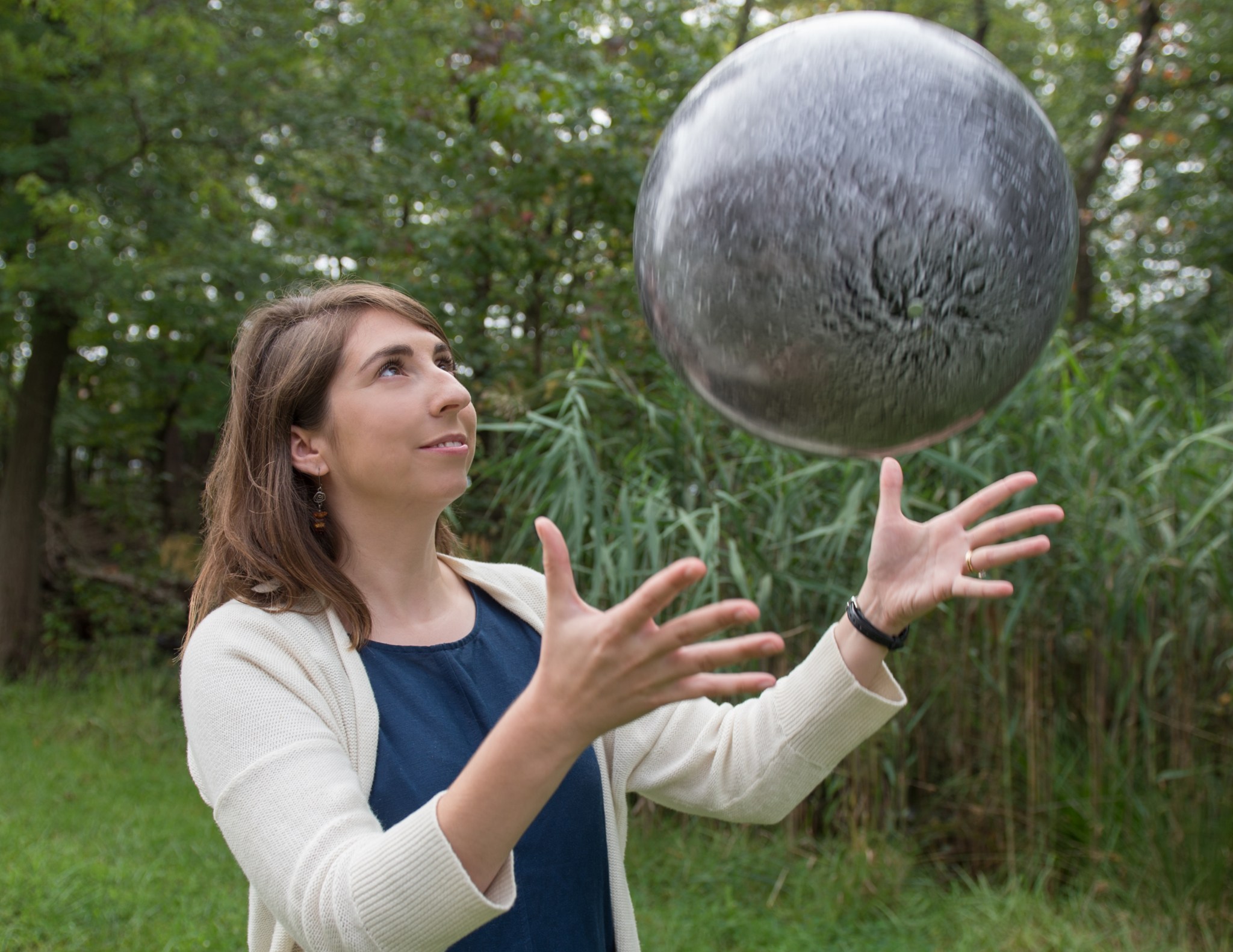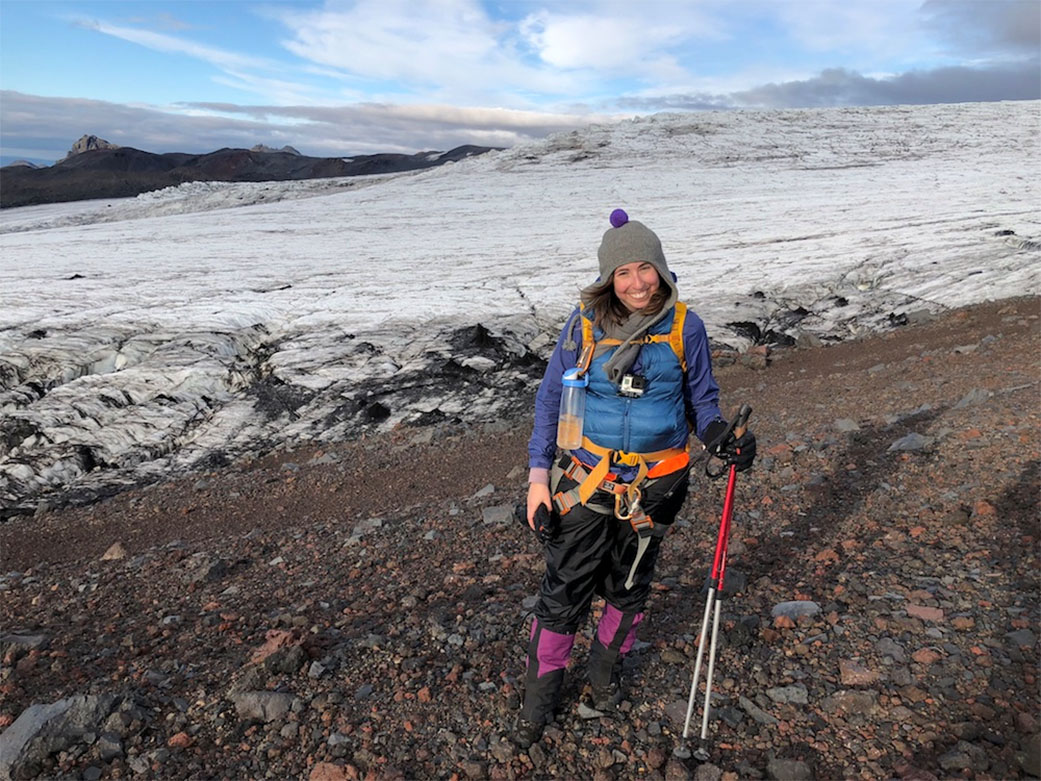
Name: Molly Wasser
Title: Outreach Coordinator
Organization: Code 690, Solar System Exploration Division, Science Mission Directorate
What do you do and what is most interesting about your role here at Goddard? How do you help support Goddard’s mission?
I support planetary science through social media and website content. I communicate Goddard’s science to the public through those means and through public engagement events. I manage NASA’s Moon-focused social media accounts, which are @LRO_NASA and @NASAMoon, so I’m the voice of the Moon for NASA on Twitter.
Were you always interested in science?
When I was young, I did not like science at all. I preferred novels to nonfiction and loved art, languages and history. And unfortunately, my science classes in high school did not encourage me to change my mind. The classes were about science instead of doing science. Since then, I have wanted to change
Then I went to Wellesley College and took astronomy my first semester as my lab requirement. Although I enjoyed it, I did not think I was very good at science. At the end of the semester, my astronomy professor asked me to become her teaching assistant and encouraged me to take more science classes. I would not be here today and would not have continued taking astronomy classes were it not for her mentorship. I think it was very important that at Wellesley, I was in an all-female environment in this male-dominated field. My science classes were nurturing and allowed for hesitant students to take an interest. I had always had this implicit bias that science was a masculine pursuit, and Wellesley helped heal me of that notion.
I ended up majoring in film studies, which is what I always wanted to do. I minored in astronomy and that had been the surprise. I loved the balance between art and science.
How does your background combine art, science and education?
After college graduation, I was all set to move to Hollywood and work in the film industry. But before I left, I met an alum who worked in science education at the Harvard Smithsonian Center for Astrophysics (CfA). She got me an internship with their Science Media Group, which made educational movies about science. I was amazed that I could combine my two passions, art and science. For the next five years, I produced educational videos about all sorts of science topics.
I wanted to learn more about education, so I got a master’s in educational technology from the Harvard Graduate School of Education. Given my own experiences, I focused on science education and in particular, on how to encourage girls to pursue science careers. While in school, I worked for HarvardX, Harvard’s online course initiative and I thought a lot about how to scale learning. I loved thinking about how to translate the classroom experience into a digital format and communicating to the public through digital experiences. Through these on-line courses, we reached people all over the world.
After a year in Austin, which included working for film director Terrence Malick, my husband and I moved to the Washington, D.C., area and I started working at Goddard Space Flight Center where I combine my passions, art, science and education, every day.
I used to joke that I spent all my time looking through lenses — a camera’s and a telescope’s. Art and science are both very visually conceptual. I love to try to visualize general relativity, cosmology and black holes. I just think they are the coolest. Imagining a graphic or a shot in a film is a similar process. And beyond that, how the universe was formed and why we are here are just incredible to think about. A lot of art comes from answering these same questions. My combination of science, art and education is unusual and has led me to many unique opportunities.
What was it like doing field work on an Icelandic glacier studying planetary analogs?

I recently returned from two-and-one-half weeks of fieldwork in Iceland. I accompanied planetary scientists from the Goddard Instrument Field Team (GIFT) on a trip to a 2014 volcanic eruption site (Holuhraun) and a glacier (Vatnajökull). We had three science teams, Team Fire, Team Ice and Team Handheld. We were there to study environments on Earth that are similar to environments on other planets, which we call planetary analogs. I went in order to communicate the science stories and process of field work.
I spent most of my time with Team Ice. We visited the Vatnajökull Glacier as an analog for Jupiter’s moon, Europa. Europa has a rocky core, an ocean, a thick ice crust, and a potential to house life. We tested instruments to see if we could detect signs of life within the ice to prepare for building an instrument to send to Europa.
I took lots of photos and video and posted on social media (see our trip with #NASAFireAndIce). The trip was great fun for me because I got to use my film background. I also captured audio. I was tromping around on the glacier, recording the crunching sounds from my crampons on the ice. We hope to put together a podcast. I also kept a written log and will post some blog entries about the experience and planetary analog studies.
How did you stay warm and dry on the glacier?
We were in Iceland in the summer. The temperature ranged from about 30 to 50 degrees Fahrenheit. The weather changes very quickly and is prone to rain. When we were on top of the glacier, we were in a cloud, which was cold and wet.
I was very nervous about my gear. You need layers, all synthetic or wool but not cotton, because cotton does not dry quickly. I wore wool socks with a silk liner. For pants, I wore a wicking base layer, light-weight hiking pants and waterproof rain pants. For the top, I wore a wicking base layer, a down vest, a synthetic down jacket and a waterproof rain jacket. Of course I wore a hat, with a purple pom pom that has been all over the world. On the glacier, I wore shoes with soles that did not bend because we attached crampons to the shoes. Basically, you stomp, not walk, up and down the glacier.
What is your next big digital project?
The Planetary Communications Teams from Goddard and NASA’s Jet Propulsion Laboratory (JPL) in Pasadena, California, are updating NASA’s solar system website. This is a place where anyone can go to learn about NASA planetary science, solar system objects and NASA planetary missions. I manage Goddard’s contributions, and in particular, I am looking forward to putting together a section about planetary analogs.
How is the Moon a bridge to planetary science? What makes the Moon special to everyone?
From a young age, a child observes the Moon and it provokes wonder about the world around them. Everyone sees that the Moon changes shape and that it’s up during the day and at night. A lot of our cultural stories are about the Moon — and we all develop personal connections to the Moon. A friend told me that her 3-year-old son said, “Mom, the Moon is following me.”
And what’s more, the Moon is accessible for viewing from all different environments. You can see the Moon from a light-polluted city or a remote field. You don’t need special equipment, so it’s a great vehicle for encouraging people to look up and consider the sky.
And I feel very lucky that I get to do outreach for planetary science, because it is so accessible to the public. You can see many of the planets in our solar system with your naked eye, and interesting features become apparent with consumer level telescopes. It’s a good way to get people hooked into space science!
What is it like to be the voice of the Moon for NASA?
I share lunar news with the public on behalf of NASA. I communicate through social media, primarily Twitter. Through our NASA Moon account, I developed a voice for the account. The Moon account is a little bit sassy because I’m a little bit sassy.
I share both scientific results and general information about the Moon. I include cultural references about the Moon in addition to the science. Every time there is a full Moon, I post common native names for the Moon, as well as holidays from some of the lunar-based calendars across the globe.
This coming year will be huge for the Moon and NASA lunar history and exploration. July 20, 2019, will be the 50th anniversary of the Apollo 11 lunar landing.
For the upcoming International Observe the Moon Night, Oct. 20, 2018, we are highlighting the past, present and future of NASA lunar exploration. I am NASA’s deputy director of International Observe the Moon Night. We have a website, moon.nasa.gov/observe, where we provide resources for events around the world, typically about 600. And here at Goddard, on Oct. 20, 2018, we will have a big event at the Visitor Center from 6 p.m. to 9 p.m. with talks, activities and observing.
It’s pretty amazing to see photos from all the events around the world. I love that I am looking at the same Moon that people in Bangladesh and Indonesia are seeing too. The Moon brings all of us together since we are all looking at the same Moon. I call it our global Moon.
Is there something surprising about you that people do not generally know?
Yes, I sew and I knit. I make some of my own clothes. When I was in Iceland, I bought Icelandic wool to make a sweater. I also have a problem of buying a lot of space-themed fabric. I like to make things.
By Elizabeth M. Jarrell
NASA Goddard Space Flight Center

























